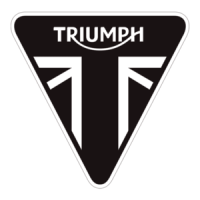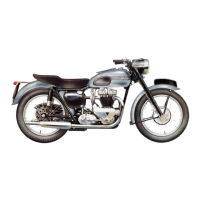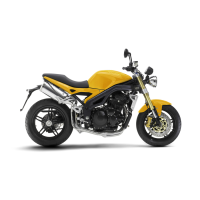The dry sump lubric3tion system
is
employed on
all
Triumph engines.
The oil is
fed by gravity from the oil tank via a filter and pipe to the pressure side of the oil
pump. The pump
is
a double plunger type, fitted with two non-return valves.
From this point the oil
is
forced through drilled passageways to the crankshaft, and
from the big end the oil issues in the form of a fog to lubricate the pistons and the
other internal engine parts.
The oil pressure
is
controlled by means of a release valve situated in the timing cover.
This valve serves two purposes,
first
to release excessive oil pressure and secondly
to indicate the pressure by visible means. The valve consists of a piston, main spring.
secondary spring, oil seal and button indicator. When the engine is running the valve
is forced back by oil pressure on the secondary spring, this being indicated by the
button projecting through the cover nut. Excessive pressure will move the piston
back still further on the main spring and allow oil to be by-passed through the release
valve body to the crankcase, from there to be scavenged
to the oil rank.
After lubricating the engine,
oil
hlls to the bottom of the crankcase where
it
is
filtered.
The crankcase oil return pipe which can be seen protruding through the
filter after the sump plate has been removed, then returns the oil to the suction side
of the oil pump to be returned
co the oil tank. The suction oil pump plunger has
twice the capacity of the pressure side, in order to make certain that no surplus oil
remains on the floor of the crankcase. To lubricate the valve rockers, oil
is
taken
from the return scavenge pipe by tapping the supply just below the oil tank. The
oil, after being forced through the rocker spindles, lubricates the valve stems and
push rod cups.
On all models, external drain pipes are fitted. These pipes collect
the oil from the valve
wells in the cylinder head and transfer
it
to the push rod cover
tubes, where
it
then lubricates the tappets and finally drains into the sump.
LUBRICATION MAINTENANCE
ENGINE
The system employed
is
simple and will function over a long period of time without
attention to the actual pumping mechanism. On the other hand, failure to observe
the eleinentary precaution of changing the oil and cleaning the filters at regular
intervals, may cause a complete breakdown due to foreign matter entering the system.
If the oil tank cap
is
removed after the engine has been started,
it
will be noted that
the return of oil to the tank via the stack pipe (seen just inside the filler aperture) is
intermittent. The reason for this
is
that the scavenge side of the oil pump has
a
greater capacity than the feed side. Therefore, the crankcase sump is kept free of
oil under normal running conditions and the scavenge pump will draw
air
until the
crankcase scavenge pipe is again submerged in oil. The air which
is
forced into the
oil tank is vented out via an outlet pipe into the primary chaincase.

